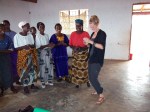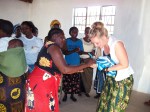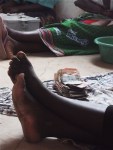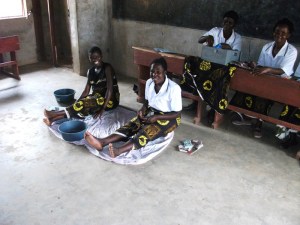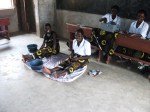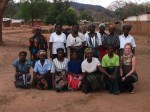This is the last guest post by Anne Sofie Hansen, who spent six weeks studying VSLAs in Northern Malawi
I am listening to an interview. Engaged in the torturous task of transcription I recall the atmosphere of the conversation. Sitting on a woven mat, in the shade of a tree. Gija, my translator and organizer, on the one side asking me how I keep my sunglasses so neat, the interviewee on the other, reminding me to stay in touch! ‘You forget us when you go back to your country. No, I will never forget Kamphenda!’. I am reminded that the distance between Copenhagen and Kamphenda is not only geographical. It stretches across culture and social divides – divides that microfinance is intended to bridge. On the long term. So, what have 5 weeks in the village taught me about the outreach and depth of Village Savings and Loans Associations? Is membership for everyone?
General Inclusiveness
Generally, the findings give an impression that the VSLAs in this northern part of Malawi are very inclusive. The trend among members, drop-outs from VSLAs and non-members has proven very positive towards including even the most vulnerable groups of the community, HIV/AIDS affected, the disabled as well as elders. However, despite the fact that many groups allow both men and women to join, it was clear that too many men in a group was not encouraged. Even though this area houses a relatively gender-enlightened population, power structures still favor men: ‘Too many men shifts power structures, they are too strong’, said one member. Only one or two male members were usually found in groups with no gender policy. Interestingly, the four groups I was investigating also represented the stretch of social levels, from the very poorest to the least vulnerable. Composition did vary between the groups but most had a broad representation.
Basic Demands – Social Networks
Despite these first encouraging words, participation did have its criteria. The basic demands for membership revolve around personal reputation and financial management skills. Firstly, during the formation process the initiators, be it after mobilization meetings from an NGO or interest created through observations of other groups, generally look to their friends and other acquaintances to create a group. Many times the individuals of the initiating group will ask other individuals within their social network to join, to reach the usual limit of 25 members. Hence, the groups are mainly formed on the basis of people who have some form of relation beforehand with at least a few other individuals of the group. A prerequisite for participation, hence, seems to be a social network.
Reputation is Everything
A few personal characteristics seem to be seminal for access to a VSLA. These characteristics were largely cross-cutting for trained and un-trained groups. This is noticeable, since the training of VSLAs includes emphasis of certain personal traits in the group selection process. The most important characteristics include trustworthiness, collaborative attitude, ability to listen to others views, hard working (as opposed to being lazy), time-consciousness, discipline, ability to pay the weekly contributions and repay loans as well as business skills. The latter two indicate that some form of financial education in terms of planning is necessary. The years of schooling seemed to be influential on this characteristic.
Characteristics that were generally exclusionary entailed reputation of stealing, being a drunkard, being a liar and moving too much between different locations whereby representation at the weekly meetings would be difficult. Hence, to gain access one must assure to keep a clean reputation. I say reputation, because most groups gathered individuals from an extensive area and many interviewees claimed that they did not know the other members very well. Hence, the words that are spoken about an individual in all corners of a village become instrumental in opening the doors to a VSLA.
Finances are Necessary
In terms of financial capacity there is an obvious barrier to access if the minimum requirements of weekly contributions cannot be met. Furthermore, most VSLAs seem to require that members take up loans during the cycle. The individuals I spoke to that were not members of a VSLA listed initial fees (including contribution to purchase of the start-kit for a group) as well as the weekly payments as the most important to non-participation. Even if initial financial help was offered to individuals with difficulties to pay these fees, some of the non-members refused to join due to expected inability to repay.
Other Issues
A few other inhibiting factors became clear from focus group discussions and interviews. Family relations, for instance, seem to play an inhibiting role. The tighter the relation, the less conducive for the running of a VSLA. Interconnectedness hinders family issues to be debated freely at the weekly meetings (an important non-financial advantage of the VSLAs), and if problems hit one member, that same problem is likely affecting a number of other members, who will consequently all need access to the pool of money at the same time. Thus, ‘our village bank will bankrupt too easily’ as one interviewee noted. Sadly, but not surprisingly, some women are prevented by their husbands to join. Interestingly though, it is not due to the enhanced economic empowerment of the woman, but rather a fear that the woman may spent her time with other men instead of attending the VSLA meeting.
Lack of sensitization is furthermore an obstacle. Some interviewees had little knowledge of VSLAs and rumors of how defaulters where treated prevented them from joining: ‘After getting something from the village bank they would come and sophisticate your belongings’, was one comment where ‘sophisticate’ is the local term for confiscate. One interviewee was reluctant to join before she had become more familiar with how a group had fared. Also, some believed that the VSLAs already provide capital from which loans can be taken directly. It therefore seems important to get the right information to the intended populations, to ensure correct understanding of the workings of VSLAs. Lastly, some failed to join merely because a group had enough members or because they missed the opportunity at the time of group formation.
‘They simply do not understand the importance of the VSLA’
To conclude the basic requirements for participation are seemingly linked to social network, personal reputation, financial planning and business skills which are linked to educational level and, off cause, capital. Even though I was overwhelmed by the success of the VSLAs in this area, and the apparent inclusiveness, I was reminded that gender issues prevail despite a relatively enlightened population and that knowledge is evermore the key to development. If you don’t understand how VSLAs work you will not understand how important it can be for you, as a very engaged VSLA member reminded me. As I grasped the core of his message: If you know, you develop!
And these shall be my final words on VSLA membership in the Northern Region of Malawi. Any comments, suggestions, additions etc. are most welcome.



 Posted by Ole Dahl Rasmussen
Posted by Ole Dahl Rasmussen 